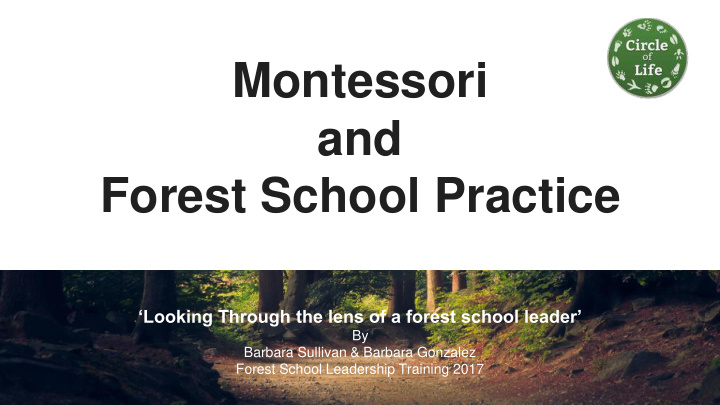



Montessori and Forest School Practice ‘Looking Through the lens of a forest school leader’ By Barbara Sullivan & Barbara Gonzalez Forest School Leadership Training 2017
Maria Montessori (1870-1952) Background: First female doctor in Italy (1896). Worked with and observed adults and children with additional needs. Designed learning materials and a classroom environment to promote children’s desire to learn. Opened first Montessori school for children in 1907 ‘ casa de Bambini ’.
Montessori Principles Prepared environment Stimulating child centred, with freedom of movement and choice. Active learning Hands on experiences with self correcting materials designed by Montessori. Active and holistic learning: children recognise their own potentials and become capable and cooperative. Mixed age groups Peer learning important Children learn at their own pace.
The role of the educator — Keeper of the environment: prepares learning materials. Introduces children to new work materials. Sits among the children, observes. Act as a guide rather than teacher. Play and discipline Children should engage in meaningful, purposeful real life activities. Believed that children develop inner discipline through taking control of their learning, through choices, clear rules and consequences. Children become disruptive only if they’re bored
The Montessori Curriculum The curriculum is divided into different areas: Practical Life Sensorial Language Maths Cultural Arts
Forest Schools and Montessori-what is similar? Principles ● Child centred. ● Observations. ● Holistic development. ● Focus on children’s choices. ● Mixed-age groups, peer learning. ● Children learn at their own pace ● Practical life skills ● Independence Environment
Routine ● Structured: free movement, circle time, individual and group activities throughout the day. ● FS: Clear beginning - middle - end. Educator ● Facilitator to support and scaffold children’s learning and development. ● Presenting materials and modelling how to use them. ● Promoting children’s independence within the environment. ● Reflective educators.
Forest Schools and Montessori-what is Different? Forest School Montessori ● ● Natural woodland Prepared environment ● environment Self-correcting ● Risk taking materials ● ● High adult child ratio Work presented ● Family can take part rigidly, left-right ● ● Appreciation of local Concept of environment normalisation ● Distinct curriculum areas
Despite differences in the building blocks for learning, there is a lot of common ground in the goals of Montessori and Forest School!
Recommend
More recommend